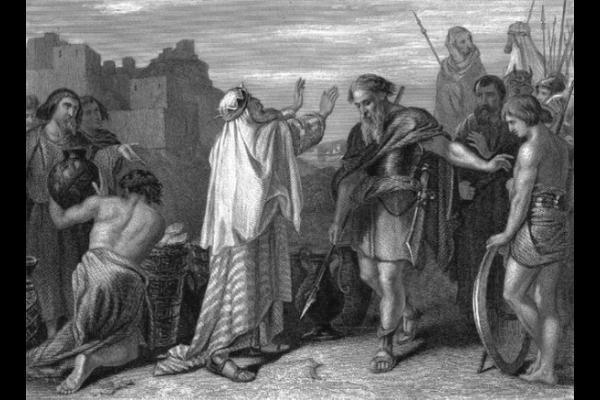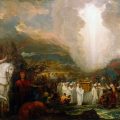Question
Dear Gramps,
Who, or what, are the Nephilim?
Susan
Answer
Dear Susan,
The Nephilim are first introduced in Genesis.
When human beings began to multiply on the face of the ground, and daughters were born to them, the sons of God saw that they were beautiful, and they took wives for themselves from all that they chose. Then the LORD said, ‘My spirit shall not abide in mortals forever, for they are flesh; their days shall be 120 years.’ The Nephilim were on the earth in those days—and also afterward—when the sons of God went in to the daughters of humans, who bore children to them. These were the heroes that were of old, warriors of renown.” (Genesis 6:1-4, NRSV)
The term “Nephilim” is derived from the Hebrew root NPL, meaning “to fall,” which leads to various interpretations regarding their nature. They are also referenced in Numbers 13:33, where the Israelite spies report seeing giants in the land of Canaan, declaring:
“There we saw the Nephilim (the Anakites come from the Nephilim); and to ourselves, we seemed like grasshoppers, and so we seemed to them.”
This dual mention in scripture highlights the Nephilim as figures associated with great might and perhaps moral failure.
1. Giants: The earliest translations, including the Septuagint, rendered “Nephilim” as “giants” (Greek: gigantes). This view has been prevalent in both Jewish and Christian traditions, suggesting that they were a race of gigantic beings.
2. Fallen Angels: A significant interpretation posits that the “sons of God” were fallen angels who took human wives, resulting in the birth of the Nephilim. This perspective is supported by various ancient texts, including the Book of Enoch, which elaborates on this narrative, describing the Nephilim as the offspring of angels and human women (1 Enoch 7).
3. Lineage of Seth and Cain: Another interpretation suggests that the “sons of God” were the descendants of Seth (the righteous lineage), while the “daughters of men” were the descendants of Cain (the wicked lineage). This view emphasizes moral decline due to intermarriage between the righteous and the wicked.
4. Warriors of Renown: Some modern scholars interpret the Nephilim not as literal giants, but as elite warriors or notable figures, focusing on their reputation rather than their physical stature. This interpretation aligns with the text’s description of them as “heroes” and “warriors of renown.”
In the doctrine of The Church of Jesus Christ of Latter-day Saints, the Nephilim are contextualized within the Book of Moses, a part of the Pearl of Great Price. Here, they are similarly described, with the Hebrew term Nephilim interpreted as giants. According to Latter-day Saint teachings, the Nephilim were likely individuals who had fallen away from the true faith.
1. Covenantal Context: Latter-day Saints emphasize the covenantal aspect of marriage. Joseph Fielding Smith stated that the “sons of God” were not angels but rather righteous men who had fallen from grace. He noted that the resulting progeny were “Nephilim” or “fallen ones,” reflecting a significant theological interpretation of the scriptural narrative.
2. Divine Displeasure: The Book of Moses illustrates that the transgressions of the sons of God (including marrying outside of divine covenant) led to widespread wickedness, which resulted in divine displeasure and ultimately the Flood. This perspective highlights the consequences of deviating from God’s commandments.
3. Cultural Context: The Church also explores how the Nephilim narrative relates to broader cultural themes. The idea of giants and demigods manifests in various ancient cultures, such as Greek mythology, demonstrating a shared human struggle with the divine. Scholars like Brian R. Doak and George E. Wright suggest that the stories of the Nephilim may have been influenced by ancient Near Eastern myths and local legends about giants and heroes, reflecting the cultural milieu of the time ([Nephilim – Wikipedia.
4. Symbolic Interpretations: Some contemporary interpretations view the Nephilim as symbolic representations of humanity’s wickedness and moral failure. This perspective serves as a narrative device to explain the great Flood and emphasize the consequences of sin.
5. Skepticism Towards Claims: While claims of fossil remains of giants have circulated, many have been debunked as hoaxes. Yet these rumors continue to fuel interest in the Nephilim and their possible historical roots.
6. Literary and Popular Culture: The Nephilim have found a place in modern literature and media, often depicted as hybrids of angels and humans, influencing narratives in fantasy genres. This portrayal reflects humanity’s fascination with the supernatural and the unknown.
The Nephilim stands as a complex and multifaceted subject in biblical scholarship. Their interpretations span from ancient texts to contemporary cultural discussions, reflecting varying theological perspectives. For members of The Church of Jesus Christ of Latter-day Saints, the Nephilim serve as a reminder of the importance of faithfulness to divine covenants and the consequences of moral failure. As we explore these ancient narratives, we are invited to reflect on their relevance to our own lives and the enduring truths they convey.
Gramps







